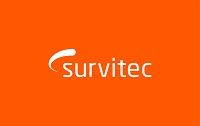SURVITEC SETS NEW STANDARD IN LIFEJACKET SAFETY WITH THE INTRODUCTION OF HALO
Safety and survival partner Survitec has introduced a completely new lifejacket designed to provide helicopter transfer passengers with a level of safety, comfort and in-water performance not currently available in the energy aviation sector.
Unveiled today at the SPE Offshore Europe exhibition, in Aberdeen, Scotland, the Halo passenger lifejacket now provides operators with the most advanced lifejacket solution available for helicopter transfer safety.
“Having launched the first passenger transfer lifejacket with compressed air in 2014, Halo was the next logical step in our mission to continuously evolve and keep our customers as safe as possible,” said Ross Wilkinson, Survitec Vice President, Northern Europe.
“With more than 60 years’ market-leading experience in lifejacket design, coupled with extensive industry insights we have been able to design a lifejacket that sets a new standard in helicopter transfer safety. Halo is a huge step forward in lifejacket comfortability and safety performance,” Wilkinson said.
Incorporating a fully integrated Emergency Breathing System (EBS), featuring a carbon composite cylinder, braided low pressure hose and second stage with integrated nose clip, Halo is significantly lighter than existing products.
At just 949g the bespoke Survitec EBS is 43% lighter than previous Survitec models and 30% lighter than competing emergency breathing systems. With a working pressure of 310 bar, the composite cylinder provides 80% more breathable air than the industry minimum standard.
Nigel Parkes, Head of Lifejacket Design, Survitec, said: “Halo is the first aviation lifejacket to utilise Fusion 3D technology, allowing for a much more ergonomic jacket that adapts to the shape of the wearer for enhanced comfort. Particular attention has been paid to improving comfort around the neck and arms. This, combined with the lifejacket’s slimline profile and the reduction in EBS size, takes into consideration the restrictive space and movement within the helicopter cabin – allowing for greater freedom of movement for the wearer during transit.”
In response to customer feedback, Survitec has incorporated bright orange Hi-Vis beaded inflation toggles, allowing for quick and easy activation. A quick-lock front buckle and easy-to-adjust straps aide quick donning.
“From day-to-day wear to deployment in an emergency situation, intuitive use, and end-user experience have been central to Halo’s development,” said Parkes. “We have gained invaluable feedback from a number of leading organisations in the industry and used this to drive the design forward, ensuring we not only meet our customers’ needs but go beyond their requirements.”
Above all it’s what’s inside that counts. Integral to Halo’s design has been the performance technology built into the lifejacket bladder, significantly increasing the safety of the user.
Should Halo need to be activated in-water, a unique buoyancy distribution system has been built in the lifejacket to offer exceptional turning speeds and increased mouth freeboard. Rotating the wearer to a face-up position, in less than three seconds, it protects the wearer’s airway and improves both body angle and face plane.
Additionally, Halo is the only aviation lifejacket offering an unparalleled chin support helping further to keep the airway fully clear of the water.
It has long been known that the use of a hood can reduce the risk of secondary drowning. Survitec’s spray hood concept works with the inflated bladder to increase visibility, reduce heat loss and keep the wearer’s airway clear.
The Halo also includes the new AU10-HTS personal location beacon (PLB) developed by Marine Rescue Technologies (MRT). This state-of-the-art PLB is capable of showing all man-overboard casualties within AIS chart plotter areas, allowing search and rescue responses to be executed quickly and more effectively.
Successful rescue is further enhanced with a strobe light, sealight light, whistle and reflective straps that help rescuers better locate the wearer. Once found, the rescuer can rapidly pull the survivor out of the water using the accessible lifting points on the front of the jacket.
The Halo passenger lifejacket is currently going through European Union Aviation Safety Agency (EASA) approvals.
For more information, contact:
Hannah Burywood
Marketing Manager, Survitec
Email: Hannah.burywood@survitecgroup.com
TeI: +44 (0) 1329 820024

